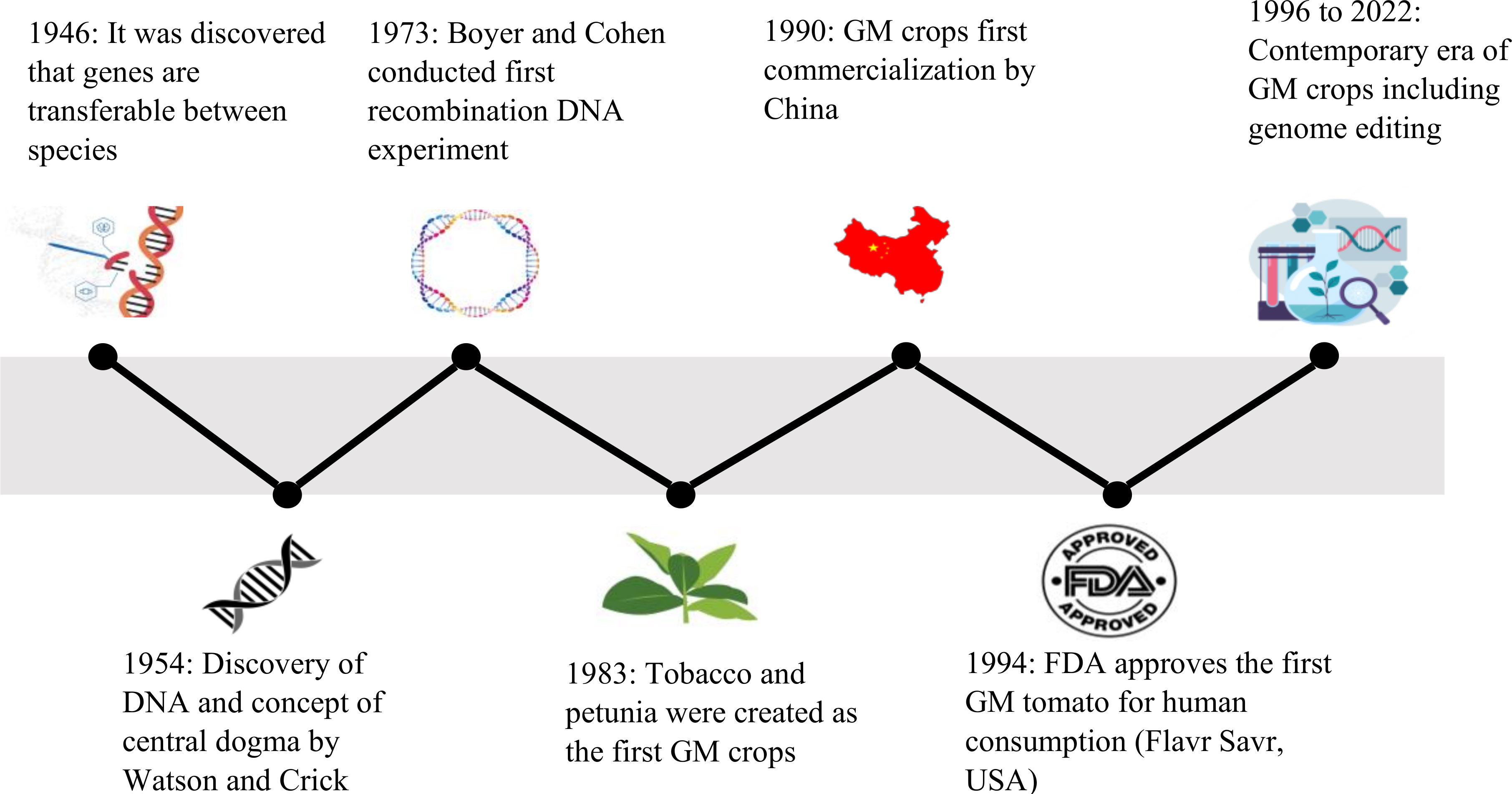Chronic hunger has worsened in recent years as a result of the rapid growth of the human population. This is one of the biggest issues we are facing in the world today. Despite considerable progress over the past 20 years, there has been a surge in global hunger. Figures from 2016 show that more than 800 million people worldwide are malnourished. Producing higher yields, and more resilient to environmental stresses, genetically modified (GM) crops may be the solution to world hunger.

Source: Freepik
However, the use of GM crops has also been a subject of public debate and controversy. GM crops raise food security concerns. Although potentially increasing production, they may also impact food quality, nutrient composition, and small-scale farmers’ income and access to food. The private sector’s control over plant genes through patents raises concerns about food security and income for small-scale farmers. Conversely, biotech companies own at least three dozen patents controlling seed germination and essential plant processes. This can potentially affect agricultural research in developing nations, threatening the livelihoods of farmers in Africa, Latin America, and Asia.
What are GM crops?
Humans have begun altering plant genetics about 10,000 years ago with artificial selection and selective breeding. Additionally, a major breakthrough in 1946 led to the genetically modified crop technology, as we know it today, discovering that genetic material can be transferred across different species (James, 2011).

Source: Aziz et al. (2022)
GM crops are plants that have had their DNA sequences altered in a way that does not occur by mating (World Health Organization, 2014) to add a desirable trait. For instance, genetic engineering can increase the amount of the target crop produced. Also, pest-resistant crops can better tolerate environmental hazards that might otherwise destroy an entire season’s worth of harvest. Evidently, genetically modified crops can be more nutrient-dense. This can help supply communities that struggle to obtain certain nutrients with vital vitamins.
Furthermore, when using pest-resistant GM crops, farmers won’t have to use pesticides that could otherwise be harmful to human health. Despite the increased cost of the seeds, genetically modified soybeans, maize, and cotton were linked to a 22% increase in production, a 37% decrease in pesticide use, and a 68% rise in profitability (Yoo, 2019). The findings of another study demonstrated that the adoption of Bacillus thuringiensis cotton by smallholder farm households in India has increased income. This had a favourable effect on their dietary quality and food security.
A review of 147 independent studies found that GM crops significantly increase yields and reduce pesticide use (Klümper & Qaim, 2014). Sharp increases in profit have alleviated rises in costs.

Source: Klümper & Qaim (2014)
Genetically Modified Crops: Health Concerns
Many concerns about the impacts of GM crops on our health, our offspring, and our DNA have been addressed and tested after more than 20 years of study by nations and researchers around the world. Several independent studies across the world have sought to test GM crops for toxic effects. Regardless of misconceptions, genetically modified crops are not hazardous, consumption effects are not handed down genetically and no evidence of gene transfer to consumers has been found.

Source: Harvard University (2015)
Genetically Modified Crops: Environmental Impact
To address food security in developing countries, understanding the environmental impact of GM crops is crucial. Genetically modified crops risk not germinating, killing creatures that aren’t pests, reducing soil fertility, and perhaps passing on insecticidal or virus-resistant traits to the crop’s wild relatives.
GM crops, despite regulations, have shown potential negative impacts on the environment. However, global data indicates that GM crops are not inherently dangerous, with widespread adoption leading to reduced herbicide and insecticide volumes, improved EIQ (environmental impact quotient) profiles, and reduced greenhouse gas emissions. The overall positive environmental impact and increased crop yields validate the use of GM technology in developing a sustainable food system.
The Solution to World Hunger: Strategies
Hunger and famine is a complex issue with multiple causes. It is caused by conflict, climate change, inequality, and the COVID-19 pandemic that have pushed millions into poverty and unemployment.
In a report presented to the United Nations, violence and conflict are said to be the primary causes of hunger globally and are hindering progress towards ending hunger and malnutrition by 2030 (SDG 2).
This emphasises the need to address the root causes of hunger and implement effective strategies to prevent and mitigate conflicts that contribute to food insecurity. Organisations such as the Global Alliance for Improved Nutrition (GAIN) and the UN World Food Program (WFP) are working to improve food security globally. Both organisations operate in over 80 countries and provide over 15 billion life-saving meals annually (The Borgen Project, 2022). The UN WFP implements the following strategies and solutions to address world hunger:
- Break the cycle of conflict and hunger. Provide food assistance to victims of extreme events
- Build community resilience to climate change. Assist farmers in learning new techniques and growing a diverse range of crops and livestock.
- Provide social safety nets to combat poverty and inequality. Increase access to national social protection systems such as food or cash assistance.
- Provide rural farmers with tools for sustainable agriculture. Provide resources to small-scale farmers in local economies that improve production and yields while developing their business and financial skills.
- Reduce food waste. Invest in modern storage equipment and innovations that allow communities to grow their own food to prevent food loss.
- Prevent malnutrition in mothers and children. Provide specialised, nutritious food children and pregnant and nursing women
moving forward
Genetically modified crops are not a one-fix solution to world hunger and malnutrition. Multifaceted approaches are necessary for these complex challenges. Nonetheless, the data hints that GM crops might play a significant role in a more comprehensive plan for food security. Appropriate policy and regulatory frameworks are necessary to ensure that the requirements of underprivileged farmers and consumers are taken into account and that unwanted social consequences are avoided.
More investment in agricultural biotechnology research, development, and education is necessary to promote the adoption of GM crops. Local scientists need be involved in developing the research plan to support decisions. The ultimate objective is to reduce hunger and malnutrition while guaranteeing the safety of GM foods.
Why is it essential that we focus on the solution to world hunger?
According to a United Nations report, global hunger increased to 828 million in 2021. This is an increase of about 46 million since 2020 and 150 million since the COVID-19 pandemic. This new data shows that we are off-track in our goal of eradicating hunger, food insecurity, and malnutrition in all of its forms by 2030. Future projections, taking into account global economic recovery, still estimate nearly 670 million people (8 percent of the world population) will face hunger in 2030.
achieving the United Nations Sustainable Development Goals (SDGs) and how they link to the solution to world hunger
Goal 2 of the Sustainable Development Goals aims to achieve zero hunger by 2030. This includes ending all forms of malnutrition, doubling agricultural productivity and the incomes of small-scale food producers, ensuring sustainable food production systems, maintaining genetic diversity, increasing investment in rural infrastructure and agricultural research, and correcting trade restrictions and distortions in agricultural markets. The goal also emphasises the importance of the proper functioning of food commodity markets and timely access to market information to limit extreme food price volatility.
A Thrivable Framework
THRIVE Project is an international research, education, and advocacy organisation that explores topics and challenges to help transform society towards ‘thrivability‘—going beyond sustainability. THRIVE believes that society can flourish towards a thrivable future by taking transformative action towards Zero Hunger (SDG 2). Food security is a vital aspect of human health and well-being and is linked to social equity, climate change, poverty, and agricultural technology.
The THRIVE Platform, which is based on the THRIVE Framework, rates the sustainability performance of the associated entity to illuminate the way forward. It allows users to measure what matters using predictive analyses to inform researchers, businesses, governments, and policymakers and support positive social and environmental transformations. For more information and to receive updates on thrivability matters, subscribe to our free newsletter, webinar events, and podcast series.
